How to make this bright, multi-purpose, plywood drawer unit
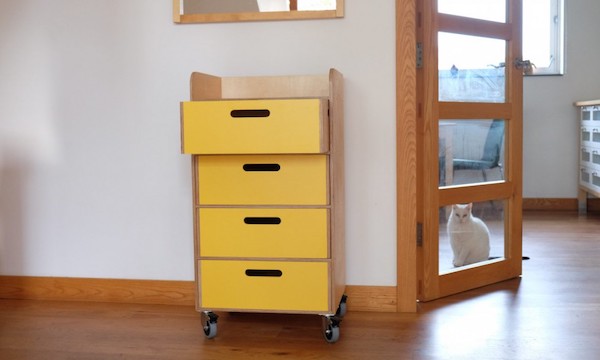
Although this contemporary design might not suit everyone’s taste, it’s still one of my favourite projects. I finished it about two years ago and it took me a ridiculous 12 months before that to make.
I’m not a designer, but I love to make things. So, in practice my ‘design’ process means slowly building a partial, but full-sized prototype, then taking bits away, and adding new bits back on again, until I’m happy.
Of course this unstructured way of working is hugely time consuming and wasteful — especially as a project can be left abandoned for months, waiting until I can solve a design problem, and then become happy with it again. Definitely not a process I’d recommend, but seemingly the only way I can work!
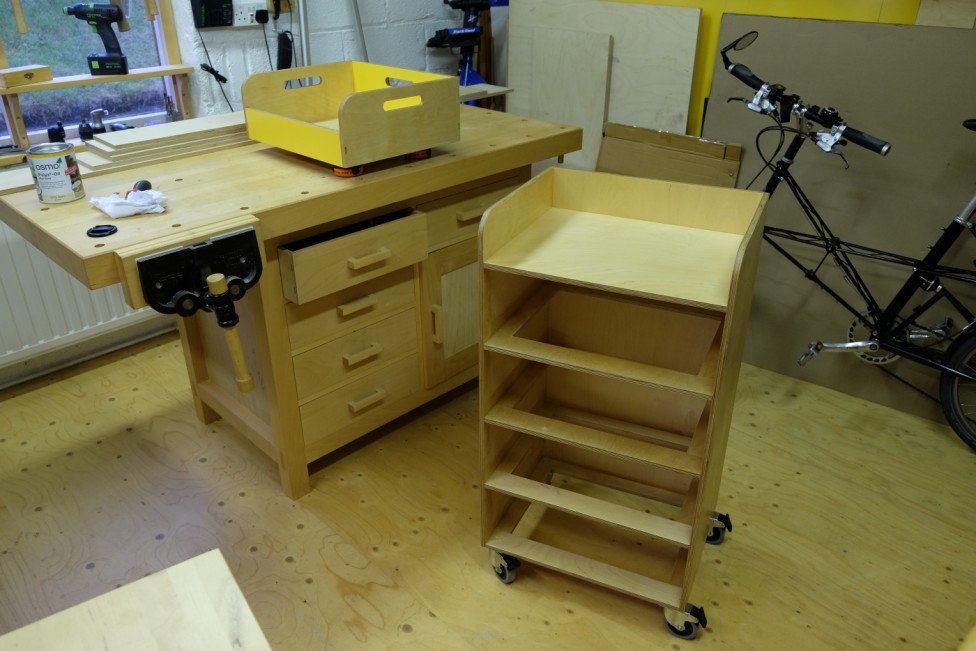
I copied the unit’s dimensions from a Muji wire-framed drawer unit we had (which really helped) and my key objective was to make it as lightweight as possible.
So I’ve made everything except the castors and the drawer bottoms from 12 mm birch plywood (instead of the usual 18 mm thickness).
Right up until the whole unit was completed, I was unsure if this thickness would be rigid or strong enough. But after it was glued up, and the first drawer was in place, it became clear that its light weight, surprising strength, and narrow-edged frame were key elements in its distinctive personality.
Together with its bright yellow fronts and cut-out drawer handles, it had become a fun and functional unit, with lots of uses throughout the home.
Design details
All the joints are simple butt joints, strengthened with Festool Dominos. These are a sort of patented floating tenon joint, made with lozenge-shaped dowels, and I’ve made these a feature by exposing them in rows on the outside of the unit. I’m lucky to have a tool for this, but a biscuit joiner would be a sensible, and much cheaper, alternative. Or this dowelling jig, which looks like a great option for a beginner. (Dowels are not as strong as Dominos or biscuits, as they have a smaller gluing surface, so you’d need to use more of them.)
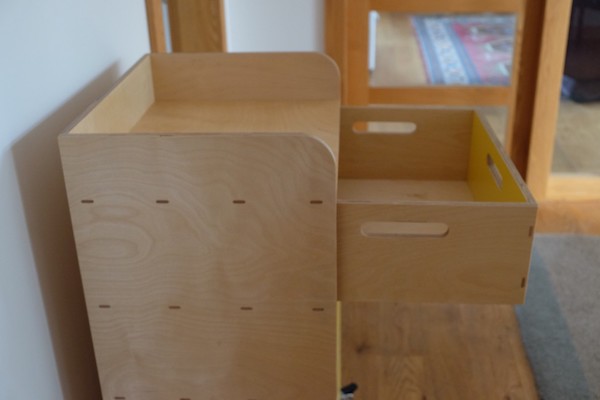
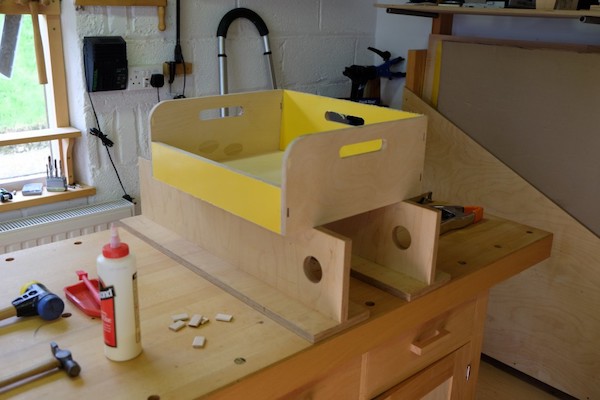
I cut the drawer fronts in half, impulsively and at the very last minute, just before final glue up. Then, after gluing the first drawer, I decided to rout a couple of extra handles in it. Finally, I began to think the design looked quite good — after all.
With a half-height end on each drawer, they can be simply reversed in their drawer openings to partly reveal their contents.
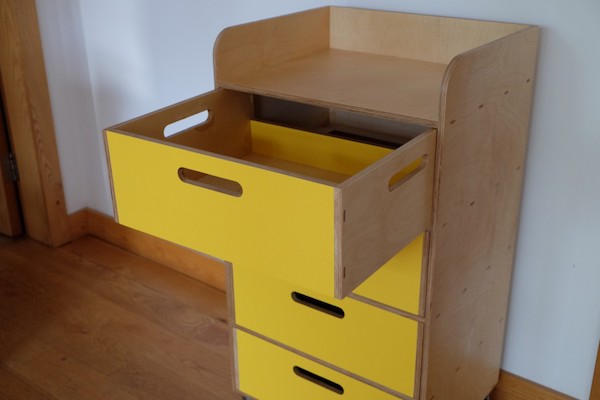
The drawers can be used like storage boxes, as well as drawers, with their hand-friendly cut-out handles on three sides. Both ends are made from 12 mm plywood too, but laminated inside and out with bright yellow Formica. I’ve never tried laminating Formica before, but this turned out to be quick and easy, using spray-on contact adhesive.
The drawer’s bottoms are 6 mm plywood, glued into a groove on all four sides, making them really strong and solid. The drawers slide on traditional runners (again made of 12 mm plywood), and I was amazed how super-smoothly they slide, with just a bit of candle wax for lubrication. Each drawer can be easily taken out and carried away, impossible if I’d used modern metal drawer runners. (Also with modern drawer runners, you’d lose some storage space, as the drawer width is narrower.)
Before I fitted castors to its base, the unit had sat for many months in my workshop with laminated plywood legs, but I eventually changed my mind and cut these off. I think these wheels add character, and of course, they’re really useful.
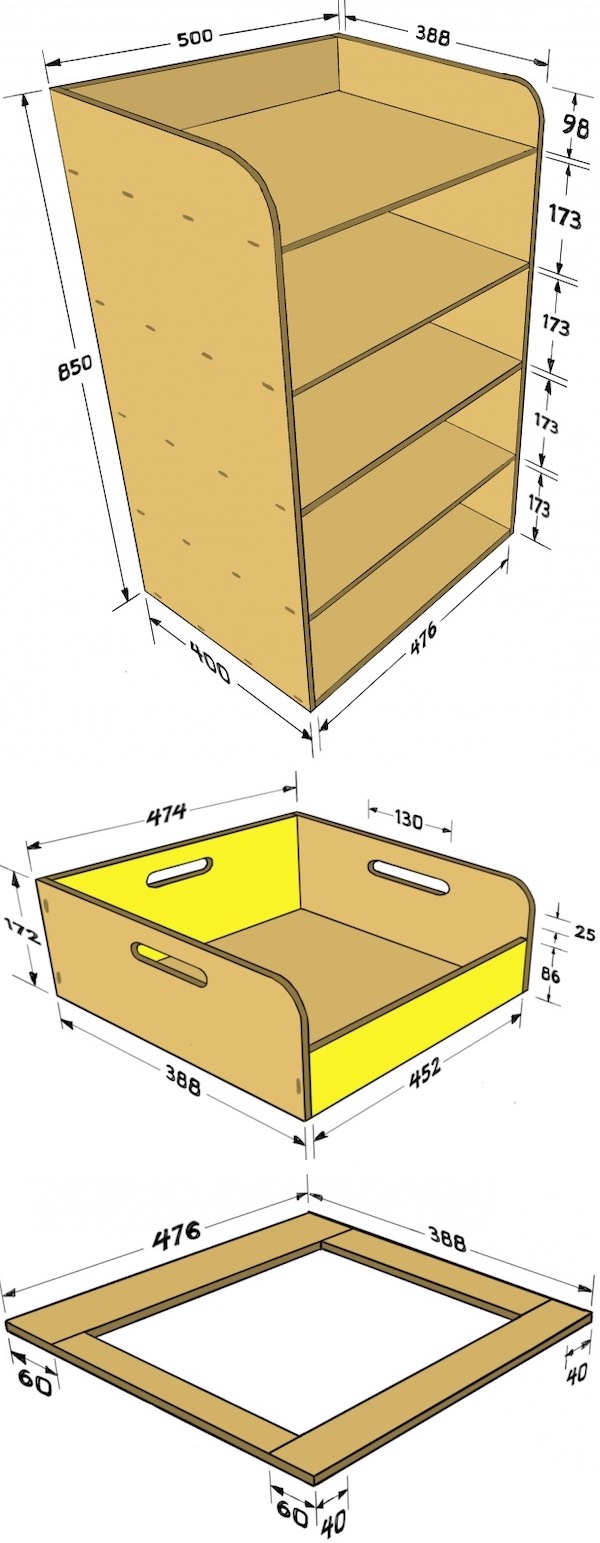
Cutting list
All dimensions in mm
- Case sides: 2 pieces, 850 x 400 x 12
- Case back: 1 piece, 850 x 476 x 12
- Case shelves/runners: 5 pieces, 476 x 388 x 12
- Drawer sides: 8 pieces, 388 x 172 x 12
- Drawer backs: 4 pieces, 452 x 172 x 12
- Drawer fronts: 4 pieces, 452 x 86 x 12
- Drawer bottoms: 4 pieces, 464 x 376 x 6.5
Cutting-out notes
Because this cutting list has so many shared dimensions, it’s easy to cut these to a consistent size by using a single setting on a table saw.
Alternatively, a rail-guided saw would work nearly as well — making sure you carefully position the guide rail every time with a marking knife and a story stick. Consistency here is much more important than absolute accuracy.
When cutting parts from a large plywood sheet, it’s often easier to cut everything square, but approximately 3 to 5 mm oversize, and then to make a second pass on a table saw, or alternatively a bearing-guided router cutter with a template — to guarantee very consistent final dimensions.
Whilst this isn’t an ideal project for beginners, and a well-equipped workshop always helps, it’s still possible to get very good results with a more basic setup. With a narrow kerf Japanese hand saw and some care, nothing is impossible.
Construction notes
I made the case frame first, and then adjusted the drawer dimensions to suit the actual finished opening sizes, allowing a 1 mm clearance vertically, and 2 mm clearance horizontally.
I made the bottom four shelves by assembling each one from four strips of 12 mm plywood with Domino edge joints, leaving a ‘hole’ in the middle and ‘runners’ at each side (note that this has been omitted in my first illustration). This significantly reduces overall weight, without sacrificing strength or rigidity, and it also helps to reduce friction on the back edge of the drawer. Alternatively, the hole could be cut out of a single piece of plywood.
All the joints are Festool 6 x 40 Domino joints, cut right through to expose the Domino dowels on the outer surface of the case and the drawers. This is just for show, and quite a lot of extra care is needed to stop the Dominos from de-laminating the outer layer of plywood when the joint is closed up during gluing. But I think it looks nice.
I cut the drawer fronts and backs exactly to size before gluing oversize pieces of yellow Formica on each side. It was easy then to trim the Formica using a router with a bearing-guided cutter. I bought a single sheet of yellow Formica and spray-on adhesive from Morlands in the UK (and I’ve still got lots left over to make more yellow things).
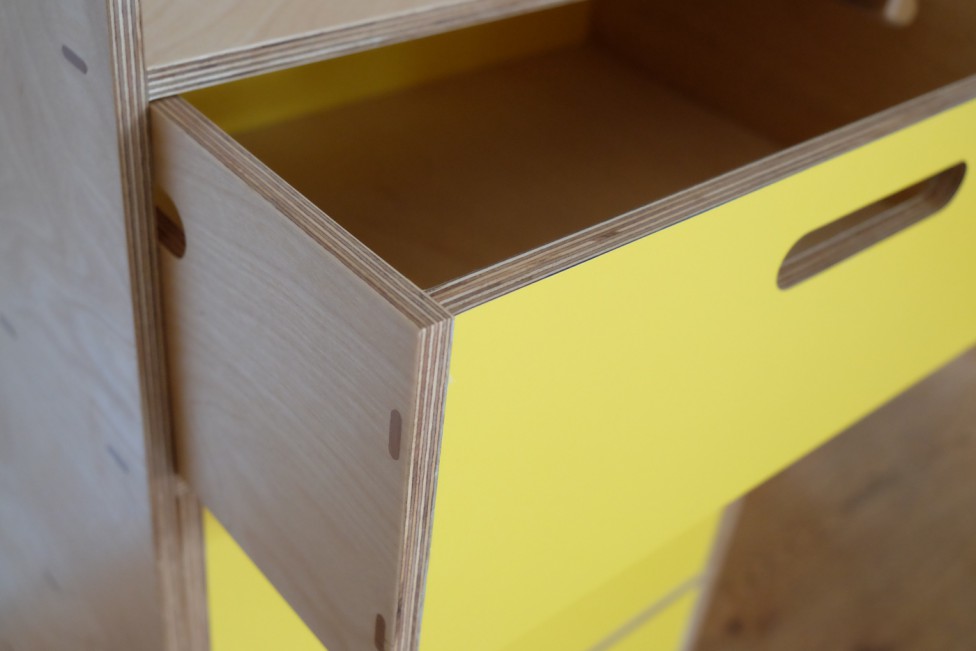
The bottom of each drawer is glued into a slot routed into the sides, back, and front of each drawer, about 6 mm in from the base edge. This is a fiddly process, and extra care is needed to make sure each drawer is exactly rectangular before the glue sets. I ended up checking each drawer mid-way through glue-up, by quickly taking all its clamps off, pushing the assembled drawer into its slot in the case, tapping it to adjust its squareness, and then carefully taking it back out and putting all the clamps back on again.
It was quicker and easier to sand almost every face surface before glue-up. Then, after glue-up, I sanded the edges smooth, and wiped on a couple of coats of Osmo Hardwax Oil, a ‘good enough’ clear finish that’s fast and easy to apply.
I routed out the drawer handles after the drawers were glued up, but before applying the Osmo oil, using a bearing-guided cutter and a thin plywood template.
Finally, I screwed a castor wheel onto each corner of the base. I chose wheels with brakes, as I thought that the whole unit might roll around whenever a drawer was opened. But in practice there is very little friction from the candle-wax lubricated drawer runners, and it might have been neater to have wheels without brakes.
After writing these notes and looking through my old photos, I’ve been re-motivated to make a couple more units in the same style, perhaps varying the layout and number of drawers. Maybe I’ll start woodworking again… when I’ve finally stopped messing about with this blog.
Omissions?
- I’ve written this blog post long after I finished the actual project, partly to try out the layout options in my new website.
- So, if I’ve left out something that’s important to you, please contact me by email.